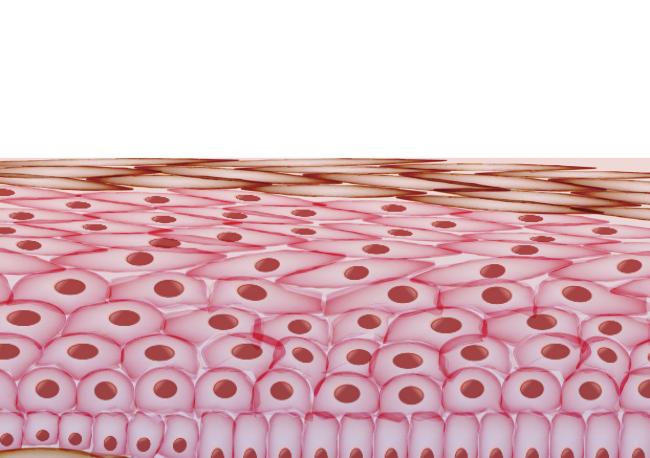Insights into skin formation
March 24, 2020
Insights into skin formation
At a Glance
- Researchers discovered how distinct liquid droplets within cells help build the skin’s outer layer.
- The study may lead to a better understanding of skin conditions like atopic dermatitis and psoriasis.

Your skin creates a barrier against the outside world. It protects you from harmful microbes that could cause infections and holds body fluids in, preventing dehydration.
The outer barrier of the skin is made of cells called keratinocytes. These cells are born in the basal (or inner) layer. They then make their way through multiple cell layers and move toward the surface. As keratinocytes travel, they make the necessary components needed for the barrier. Once they reach the outer layer, the cells flatten and spill out their contents to form squames, the top layers of cells that form your skin’s outer barrier.
When cells reach the layer just below the squames, they temporarily acquire liquid-like droplets called keratohyalin granules (KGs). These droplets assemble from a protein called filaggrin. Mutations in this protein have been linked to certain skin conditions like ichthyosis vulgaris, which causes dry, thickened skin. Filaggrin accumulates as the cells move upward, causing KGs to become bigger and more viscous, like glue. Suddenly, these granules disappear, and the cells flatten and form squames.
A team led by Dr. Elaine Fuchs at Rockefeller University used human skin cells and mouse models to study filaggrin’s role in KG formation. The study was funded in part by NIH’s National Institute of Arthritis and Musculoskeletal and Skin Diseases (NIAMS). Results were published online on March 13, 2020, in Science.
The team engineered genes encoding fluorescently labeled proteins of one to 16 filaggrin units (humans have 12). They inserted these genes into human skin cells. Using live cell imaging, they found that a single filaggrin alone dispersed into the cytoplasm, whereas four or more units together could form KGs, but only at artificially high concentrations. Ten to twelve units appeared to be the optimal number for efficient formation of liquid droplets, which occured in a process called liquid-liquid phase separation.
The researchers then created special sensors to track KG formation and genetically incorporated the sensors into mouse skin cells. They also incorporated pH sensors. They found that the change in pH level near the skin surface causes KG droplets to dissolve. Prior to dissolution, the droplets began crowding together in the cells’ cytoplasm, physically distorting the cells’ internal components. Within two hours of these events, as the pH became more acidic, the cells suddenly formed squames.
“Throughout our lifetime, squames are continually being shed from the skin surface and replaced by inner cells moving outward,” Fuchs explains. “We’ve identified the mechanism that allows skin cells to sense new changes in their environment and very quickly deploy instructions to drive squame formation.”
These findings show that if filaggrin isn’t functioning properly, phase separation fails to occur, and KGs don’t form in the skin. This may contribute to defects in building the skin barrier and lead to conditions like atopic dermatitis and psoriasis.
“Most treatments [for skin conditions linked to mutations in filaggrin] developed thus far have been focused on suppressing the immune system, but our findings suggest that we should be looking more closely into the barrier itself,” Fuchs says.
—by Tianna Hicklin, Ph.D.
Related Links
- Skin Microbes Fairly Stable Over Time
- Skin Microbes and the Immune Response
- Keep Your Skin Healthy: Protecting Your Outer Self
- Ichthyosis
- Atopic Dermatitis
- Psoriasis


